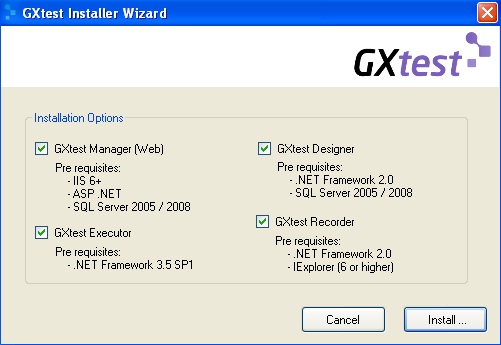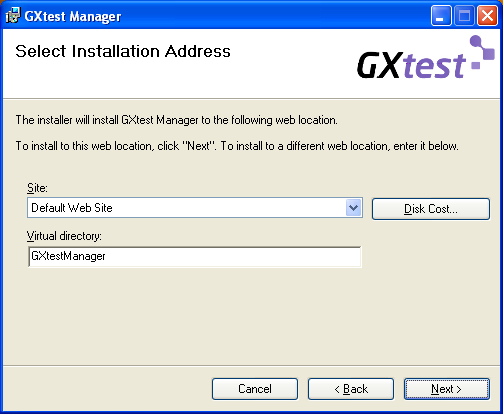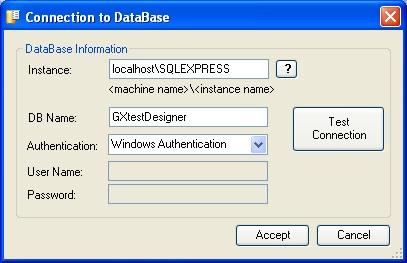Old GXtest Installation guide
This Installation Guide is for GXtest 1.1.7 and older versions.
The various components to install are listed below:
- GXtest Designer and GXtest Recorder to create and edit Test Cases
- GXtest Manager (GXtest Daemon and GXtest Executors included) to schedule the tests to be executed
- GXtest Extension, useful to export the GeneXus KB (X, Ev1 or upper)
GXtest Designer has to be installed on machines where users want to model the test cases. If you install this component alone (without GXtest Manager), users will be able to create and execute test cases, but they will can't schedulle and execute tests until GXtest Manager is installed.
Additionally, where installing a GXtest Designer you need to install a GXtest Recorder to record test cases from Internet Explorer.
The component GXtest Recorder can be installed without the GXtest Designer, in order to record test cases and save them as compressed XML files that can be sent afterwards to the user who is using GXtest Designer. This user then will be able to import and use them in any project.
GXtest Manager is installed as a Web application in a .NET environment. It can be remotely accessed by different users. At the same server (not necessarily) the GXtest Daemon component must be running. This component checks if there are scheduled tasks ready to be executed, and makes them execute in the machine specified in the GXtest Executor component.
As a result, there can be several GXtest Executors where tests are ran effectively. They must have access to both the GXtest Manager database and to the application under test (across http).
Contents |
Prerequisites
You must have SQLServer 2005/2008. If you don't have SQLServer 2005/2008 installed you can find the Express version for free download here.
GXtest works on Windows XP® (SP2), Windows Vista® and Windows 7® operating systems, with Internet Explorer® version 6, 7 and 8. It is necessary to have the .Net Framework already installed.
No special hardware requirements are defined to run this application.
It is also necessary for the execution of GXtest Manager to have installed the IIS web server - Internet Information Services, which is packaged as a Windows component.
Installation (step by step)
GXtest has an installer which shows the various components components that can be installed. You must first select which components you want to install and then each component is configured via a Wizard.
Typical installation: The typical installation consists of having a PC (or server) with the GXtest Manager and with one GXtest Executor to run unattended tests, and a Tester's PC with the GXtest Designer and Recorder.
Then, in order to achieve this configuration in the server PC, you would only select GXtest Manager and Executor in the GXtest installer and in the Tester's PC you would run the same GXtest installer selecting only GXtest Designer and Recorder components.
We recommend first installing the server side and then the "clients" or testers. In turn, consider GXtest Designer can work "offline" of GXtest Manager, in a local database. However, it is recommended for simplicity to work from the GXtest Designer installed on the same GXtest Manager database.
- Note: The installation will be done in the C: drive so if you want to install on another drive you need to run one by one the MSI attached to the installer. The Manager is installed in the directory of the Internet Information Server.
GXtest Manager Installation
If you select to start installing the GXtest Manager, then a simple wizard will run for installation.
- First, the installer displays the welcome window. Press "Next".
- Then the installer lets you choose the virtual directory where the web application is going to be installed. If the installation is being done in Windows Vista, Windows 7, you may also specify the Application Pool desired. In this combo select the "Classic. NET AppPool" and then click "Next".
- Pressing the "Next" button will display the product license. It is important to read it before accepting it. Should you agree with the terms, select "I Agree" and then press the "Next" button. Check again after the installation by pressing "Next".
- After the installation wizard displays a progress bar the following window will be displayed.
In this window you must enter the SQLServer instance to be used by GXtest Manager. - This window lets you configure the connection to the database. Be sure you have SQLServer installed before continuing. Basically, you have to enter the data base Instance (computer name, the "\" char and the name of the database instance). By default, the instance name of the SQL Server Express version is "SQLEXPRESS".
- Then click "Accept". The system asks if you want to create the schema of the database. If this is not your first installation, the program will warn you that it has already found a database (indicating the version) and it will ask you what to do.
The options are:- To migrate ("Run Migration") maintaining the current data base (this is the recommended option if your database has a previous version).
- Override base ("Overwrite database"), deleting the current data.
- Take no action on the database ("Do nothing").
- You have successfully installed GXtest Manager on your system.
After installing the Manager you must reboot the machine, or start manually GXtest Daemon service. Then every time you start the machine this service will start automatically. In order to work properly, you must have entered the license, so you should restart the machine after enabling it.
GXtest Executor Installation
On every machine you wish to run schedulled tests, GXtest Executor must be installed. This is an application that is accessible on the System Tray. After installed you have to run it manually from the Start menu. Every time you reboot the system it will run automatically.
For more configuration details see GXtest Executor User's Manual.
GXtest Designer Installation
If you select to start installing GXtest Designer then a very simple wizard will run for installation.
- Pressing the "Next" button will display the product license. It is important to read it before accepting it. If you agree with the terms, select "I Agree" and then press the "Next" button.
- Then it is necessary to indicate the folder where you will install the product and who will have access to it, if only the current user (Just me) or everyone in the team (Everyone) and then press "Next".
- (Optional) Then confirm the installation by pressing "Next". A progress bar will be displayed, and you will see the following window (will appear only when not installing GXtest Manager):
This window lets you configure the connection to the database. If you don't want to configure the connection to the database at this point you can press "Cancel" and the installation finishes successfully, but without setting the connection to the database. If you want to configure the connection, make sure you have SQLServer installed before continuing. Basically, you have to enter the database Instance (computer name, the "\" char and the name of the database instance). By default, the instance name of the SQL Server Express version is "SQLEXPRESS". - You can verify if the database connection is correct by pressing the button "Test Connection".
- Then click "Accept". The system will ask if you want to create the database schema. If this is not your first installation and you don't want to overwrite the current database press "No", otherwise click "Yes" (recommended).
See also how to edit connections. From one GXtest Designer you can access different databases (different installations of GXtest Designer, or GXtest Manager Database).
GXtest Recorder Installation
If you select to start installing GXtest Recorder, then a very simple wizard will run for installation with no user interaction required.
If the product is properly installed open Internet Explorer®, go to "View -> Toolbar" and select GXtest Recorder. At that time you will see a toolbar like this:
GXtest Extension Installation
The GXtest Extension is useful for the task of exporting the KB of the application under test in order to import it in GXtest. It installs like any other GeneXus Extension and will only work with GeneXus X or higher.
You must copy the file "GXtest Extension.dll" to the Packages folder within the GeneXus installation folder (where the executable GeneXus.exe is). The GXtest Extendion.dll to be used must correspond to the version of GeneXus with which you want to work. Then you must restart GeneXus and a new menu GXtest must be enabled in Extensions menu.
Uninstallation
To proceed with the uninstallation of the application you must go to "Control Panel / Add or Remove Programs" and look for GXtest entries, select them one by one and press "Remove".
License Activation
GXtest uses the same mechanism that GeneXus for licensing through the License Manager GXtest included in the installation folder. To activate the product once installed it is necessary to request a license.
Also, a trial license may be requested by: Authorize -> Request License -> Authorize Online.
For more information visit http://wiki.gxtechnical.com/commwiki/servlet/hwiki?GeneXus+X+Protection+Manual
The Executor and Recorder components can be installed on different machines without any problem.
It is important to run the License Manager as an administrator in Windows Vista and Windows 7.




